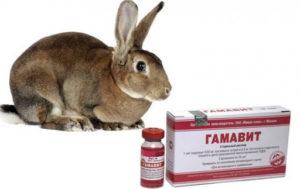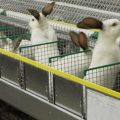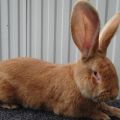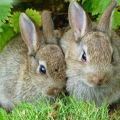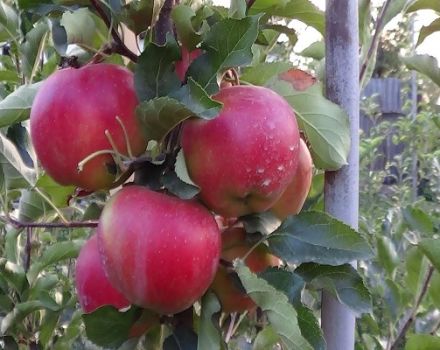Description and characteristics of stroach rabbits, breeding rules
The stroach rabbits were first bred in Germany. Their meat is a valuable and nutritious product. Rabbits are large in size and spotted in color. Caring for and breeding a breed for commercial purposes requires specialized knowledge and experience. In general, the breed is unpretentious. Strings are friendly in nature, resemble a panda in color, so they are turned on like pets.
History of origin
The Strokach rabbit is also known as the German giant. Work on breeding the breed began in the 18th century. The progenitors of giant rabbits are the Belgian large flanders and the English spotted ones. From them, the strokers inherited their ponderousness and variegated color. In subsequent generations, the best qualities of the ancestors increased. Strokachi were recognized as a separate breed of rabbits in the early 20th century.
Description and characteristics of the rabbit strokach
External features of the breed:
- body length - 70 centimeters;
- erect ears - 16 centimeters in length;
- the body is elongated;
- round croup;
- weight - 5-11 kilograms;
- the main color of the coat is white;
- line on the back, spots - blue, black and gray;
- eyes are shiny, brown;
- the nose is black;
- the neck is short, merges smoothly into the chest;
- the coat is dense, thick, 3 centimeters long.
Male German giants have round heads. Females are smaller in size, fat dewlap and oval head.
A distinctive feature of the German giants is dark ears, from which a strip up to 3 centimeters wide stretches along the spine and ends with a spot on the tail.
The spots are also located on the sides, paws, eyes. On the sides there are 8-10 markings with clear contours. The nose covers a pattern that resembles the wings of a butterfly. A marriage is a deviation of color from the three standard colors.
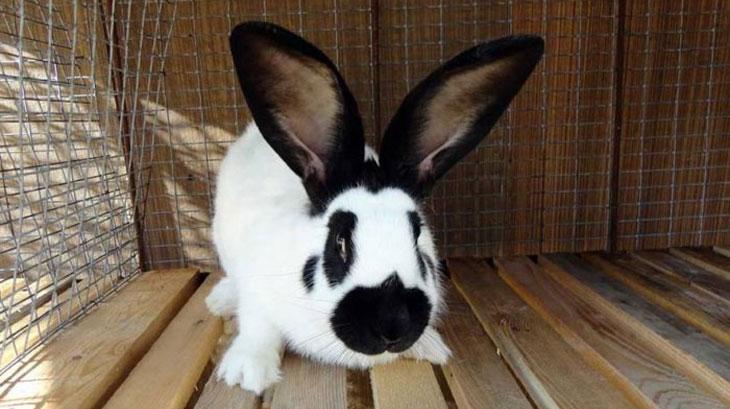
Rabbits of the German breed reach their maximum weight by 8 months. Light but strong bones make up a small part of the volume. 55-60% of the carcass weight is used for meat products. Strokachi are able to reproduce from 4 months. In one litter, 7 to 10 rabbits are born.
Pros and cons
Rowling rabbit farms are located in Europe. Domestic breeders also became interested in German giants. High product quality increases customer demand.
Positive qualities of the breed:
- fertility;
- soft meat;
- undemanding to feed;
- high survival rate of offspring;
- attractive color of skins.
String fur is also popular and highly prized. There are no negative aspects of breeding German giants. Diseases and low reproduction occur under unfavorable conditions of detention.

Care and maintenance
Requirements for an aviary for a sturgeon rabbit:
- wooden floor from slats or solid boards;
- space for a standard individual - 100x75x50 centimeters;
- the size of the cage for male-producers and females with offspring - 160x100x60 centimeters;
- bunker feeders;
- summer bedding - sawdust;
- winter bedding - hay.
German giants have sensitive skin prone to pododermatitis. The disease affects the paws of heavy rabbits living in metal cages at high temperatures and high humidity.
Strawlers tolerate cold well. But in the room for permanent maintenance, it is necessary to carry out heating and ventilation. In summer, open-air cages can be set up in the fresh air, and rabbits can be released to walk in a fenced shaded enclosure. Due to their heavy weight, they move little. To protect the stalkers from the sun, drafts and precipitation, a canopy should be placed over the walking enclosure.

When kept indoors, bright lighting should be installed. In the dark, the activity of animals decreases. Special feeders contribute to the rapid weight gain of the stringers. When food is always available, rabbits eat up to 10 times a day. Young purchased rabbits are placed in a separate enclosure. They must be quarantined for 2 weeks. If the animals are healthy, they are planted with other rabbits.
Cubs are vaccinated at the age of 1.5 months, and then they are re-vaccinated every six months. 2 months before slaughter, the animals are no longer given the vaccine.
German giants weigh 4-5 kilograms by 5 months, and at 8 months they reach 6-10 kilograms. Especially large individuals gain 11 kilograms. Eight month old rabbits are sent to slaughter. If you feed them further, the weight will increase. But the meat will get tough.
Feeding features
The rate of weight gain depends on the diet. Rabbits on a balanced feed gain 1.5 kilograms per month. The traditional rabbit diet is suitable for strollers. They absorb dry compound feed well. Individuals intended for slaughter, pregnant females and after birth are given the maximum amount of food. Due to a lack of nutrients, rabbits lose milk.

Feeding females, which are used in breeding, consists of hay and grass. They can eat plant food around the clock. Cereals and concentrates in large quantities lead to obesity and infertility. They are given 1-2 times a day. Male producers are also fed in portions.
The food of the stringers consists of green, roughage and vegetables. The summer diet of the German giants consists of dandelions, clover, sage, tansy and alfalfa. In winter, fresh herbs are replaced with straw. The diet of rabbits also includes green twigs of fruit and conifers.
Roughage includes:
- cereals;
- beans;
- corn;
- bran;
- silage.
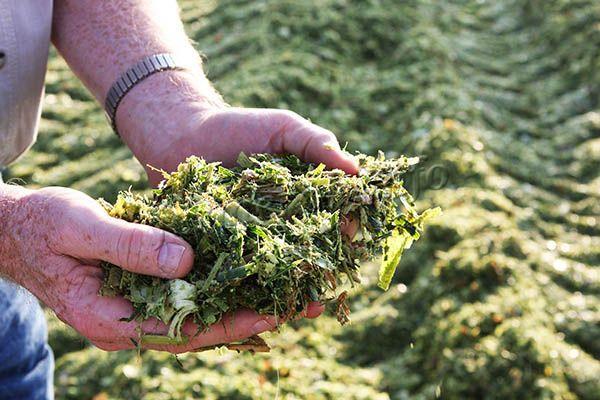
Rabbits are fed with raw and boiled root crops and fruits. Small quantities of cabbage, beets, green salad are given. These vegetables cause indigestion in the stringy.
How to breed rabbits correctly
The farms contain 2-3 male producers. Fertile males of the streak breed fertilize 15 females. Strokachi differ from other breeds by their rapid puberty. Females are ready for mating from 4.5 months. But breeders wait another 1-2 months. With early mating, weak offspring are born. Males become sexually mature at 6 months. The best time of the year for mating is spring and summer. During the warmer months, animals can be fed with fresh herbs rich in natural vitamins.
For breeding, a purebred pair is chosen so that the rabbits inherit a specific color and genotype. Parents with color defects give the same offspring. Mating of a purebred male and a non-purebred female is allowed. In this case, some of the babies will retain the characteristics of a pure breed.
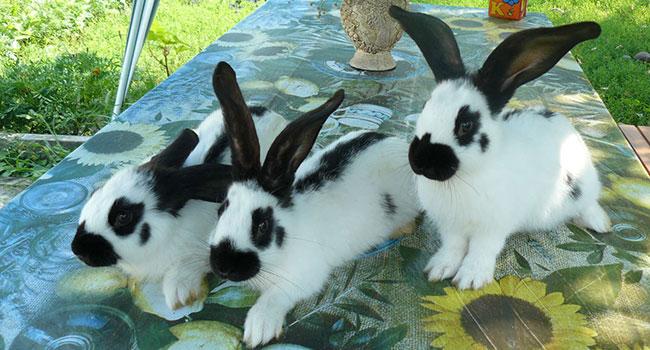
Breeding
Rabbits' pregnancy lasts 1 month.On the 24th day, they are placed in a separate cage equipped with a mother liquor for placing rabbits. Females are fed individually. They are given more water to produce milk. In a common cage, rabbits will not be able to get enough fluid. If the female has little milk, she will not be able to feed the cubs and will gnaw them.
Rabbits also need a separate space in order to prepare a nest for babies. If the female pulls out the fur on the chest, this is a sign of the approach of okrol. She insulates the cage with wool, and after a week the rabbits appear.
After birth, the cubs stay with their mother for 3 months. Two-week-old rabbits leave the brood at night. Females always take care of their offspring. Rabbits receive immunity with breast milk. At the beginning of the second month of life, they are fed with herbs, vegetables and grains. After the end of feeding, the babies are left with their mother for another 2 weeks and transferred to an adult diet.

The main mistake in breeding strings is the early absence of rabbits from their mother. Bunnies that are planted early lose their appetite and die.
How to choose a rowan rabbit and how much does it cost
Rabbits of German giants are chosen for breeding or obtaining meat. In this case, pay attention to the color of the spots and the line on the back.
Defective signs are a discontinuous stripe and non-standard colors. Color deviations mean that individuals are not suitable for breeding. The gain in weight and quality of meat in defective rabbits does not decrease.
Signs of purebred strings:
- bright markings and stripe with clear boundaries;
- pure white with gray, black markings;
- weight 5-10 kilograms;
- calm character.
When buying, you need to observe the behavior of animals. Do not take aggressive rabbits, as this is a sign of impurity in the breed.
Strings are sold by private breeders. The cost of baby rabbits varies from 300 to 750 rubles. For adult males and females, they ask for 850 to 2500 rubles. Mestizos are given for a low price. Before buying, you need to clarify whether the rabbits are pure breed.
